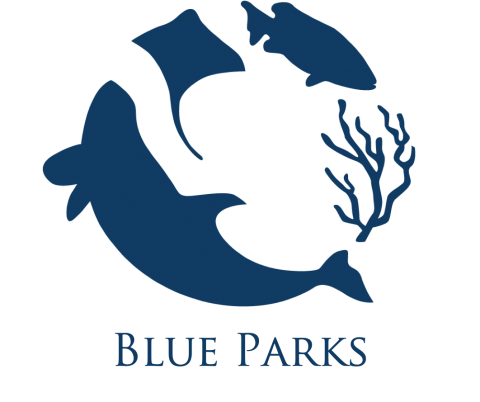
Today at the Ocean Conference in Oslo, Norway, Marine Conservation Institute and its international science council recognized Aldabra Atoll Special Reserve of the Seychelles, in the western Indian Ocean, as an outstanding marine protected area (MPA) with a Blue Park designation. Aldabra was awarded the Platinum Level Blue Park status which is the highest level award. A total of 16 MPAs now hold the prestigious Blue Park Award indicating that they meet the highest science-based standards for marine life protection and management. This Blue Park Award recognizes outstanding efforts by the Government of Seychelles, the Seychelles Islands Foundation, and MPA managers and staff who effectively protect this spectacular marine ecosystem now and into the future. This is Aldabra’s fifth international designation which recognizes its unique and special ecosystems. Public recognition and an elevated status gives incentives to decision makers and nations to create additional well protected and managed MPAs.
Dr Frauke Fleischer-Dogley, Chief Executive Officer of Seychelles Islands Foundation, said, “We are thrilled to receive this prestigious award for the unique and spectacular treasure that is Aldabra Atoll. My personal mission over the last 30 years has been to ensure that nature conservation and protected area management is firmly based on science. This award recognizes these efforts and shows the world that science-based management is possible in a region which has very limited resources for science and research. Commitment and strong collaborations by stakeholders at local, national and international level makes this possible. I hope that more protected area practitioners will follow this lead and that governments internationally will assist with resources so that we can achieve effective protection for all the special places on our planet.”
“Our goal is to recognize those MPAs like the Aldabra Atoll Special Reserve that deliver real results for marine life conservation and inspire others around the world to strongly protect 30% of the ocean’s most important places by 2030,” said Dr. Lance Morgan, President of Marine Conservation Institute. “We hope that Blue Park recognition of the Aldabra Atoll Special Reserve provides a shining example of regional marine conservation efforts and inspires others to follow the same path to protect our oceans for generations to come.”
After months of rigorous review by Marine Conservation Institute and an independent science council, today’s announcement welcomes the Aldabra Atoll Special Reserve and its management team into a growing Blue Park network around the world; Aldabra Atoll Special Reserve is 2,559 km2 or 988 mi2 in size. (See this link for detailed information on Aldabra Atoll Special Reserve, each 2019 Blue Park Award winner, and the Blue Park program: https://marine-conservation.box.com/s/xfh3bs9tn0ydh2c45vkdzq5vrz367l7p.)
Several different types of marine habitat exist at Aldabra Atoll Special Reserve: coral reefs, seagrass beds, rocky shoreline, sand bars and mangroves. Because of the varied habitats, this Blue Park is home to an abundance of many species found only in the Seychelles. It has highly diverse marine life, from green and hawksbill sea turtles, to manta rays, tiger sharks, dugongs, and humpback whales. Over 300 species of fish including 14 species of shark and 14 species of marine mammal have been observed at Aldabra and top marine predators exist in large, healthy populations. Aldabra hosts the largest breeding population of frigatebirds — a black, goose-sized seabird — in the Indian Ocean, alongside the endangered Napoleon wrasse — a massive coral reef fish that can grow over 6 feet long. The last remaining population of dugongs, marine mammals related to manatees, in the Seychelles Archipelago occur in Aldabra’s waters. The Aldabra Atoll Special Reserve is difficult for humans to access because it is so remote. As a result, the ecosystem remains relatively intact, meaning the waters house healthy populations of many coral species and represent a natural Seychelles marine ecosystem no longer found around inhabited islands of the Seychelles. Scientists think Aldabra’s lack of human impacts also may make it more resilient to coral bleaching.
The other newly awarded MPAs include:
- Arnavon Community Marine Park, Solomon Islands, 169 km2 and 65 mi2
- Area Marina Protetta di Torre Guaceto, Italy. Size is 22 km2 or 9 mi2
- Marine Protected Areas around the Northern Channel Islands, California, USA. Size is 3,804 km2 or 1,469 mi2
- Parque Nacional Isla del Coco, Costa Rica. Size is 2,011 km2 or 777 mi2
- Reserva Marina de Galápagos, Ecuador. Size is 138,000 km2 or 53,282 mi2
Total Area for 2019 Blue Park Awardees is 146,565 km2 or 56,590 mi2 which is about one tenth the size of Madagascar or Kenya and the same size as Croatia.
“Blue Parks like the Aldabra Atoll Special Reserve are the antidotes to the barrage of threats to life in our oceans,” said Dr. Sarah Hameed, Senior Scientist of Marine Conservation Institute. “We may not be able to stop climate change impacts immediately, but we can create or maintain strong protected areas in the right places today which will enable ecosystems to build or maintain resilience for the future. That’s the objective of each Blue Park.”
“This is a time of great peril for ocean life as it faces off against increasing marine industrialization and climate change,” said Professor Douglas McCauley of UC Santa Barbara, Director of the Benioff Ocean Initiative and a member of the international science council for Blue Parks, “Blue Park Awards are shining a light on protected areas that are leading efforts to protect marine biodiversity and help promote resiliency to climate change impacts.”
A growing number of countries and conservation organizations are encouraging the creation of hundreds of new protected areas to reach the world’s Sustainable Development Goal of 10% of our oceans by 2020 and the proposed goal of 30% target by 2030. Marine Conservation Institute is working to ensure as many MPAs as possible meet the high conservation standards of Blue Parks.
“Many of today’s marine protected areas do not offer effective protection and don’t protect the best places,” continued Dr. Hameed. “They’re often ‘paper parks’ appearing to meet national commitments but lacking substance. But Aldabra Atoll Special Reserve meets science-based standards we know will protect the oceans for generations to come. If we elevate and bring recognition to Blue Parks like Aldabra, we believe it will encourage more countries and leaders to satisfy this critical standard going forward.”
Today’s 6 winners join 10 prestigious 2017 & 2018 awardees. The network now includes 16 Blue Parks covering 1,669,388 km2 or 644,404 mi2 of ocean about the size of South Sudan or twice the size of Ivory Coast. These outstanding marine protected areas are securing lasting protection for marine biodiversity, and their work and hard-won recognition has already inspired others to work towards a Blue Park Award. Nominations for the 2020 awards can be made through mid-March. Visit blueparks.org to find out how your marine protected area can become a Blue Park.






